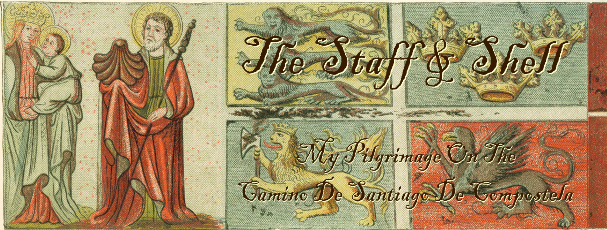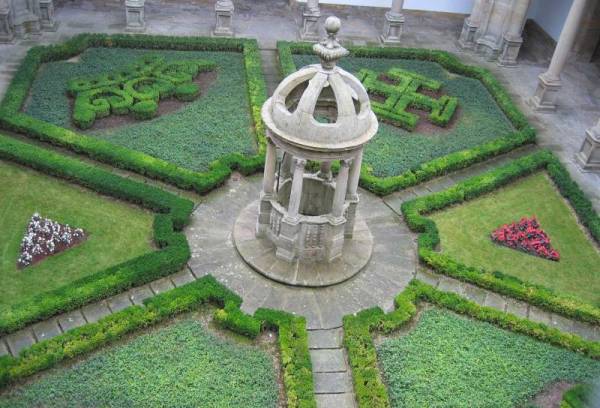 Everyday for the past 1200 years pilgrims who have been walking the ancient road to the city of Santiago de Compostela arrive and celebrate the completion of their journey. They applaud each other, relive moments of shared excitement, and honor their accomplishment.
Everyday for the past 1200 years pilgrims who have been walking the ancient road to the city of Santiago de Compostela arrive and celebrate the completion of their journey. They applaud each other, relive moments of shared excitement, and honor their accomplishment.Pilgrims enter the historic city at the "Door of the Way", which was one of the original doorways in the walls of the medieval city. The pilgrims are heading for Santiago’s great Cathedral.
THE DOOR OF THE WAY
Construction of the Cathedral began in 1075. It is the work of many craftsmen and incorporates various architectural styles.
The most famous image of the Cathedral is the main façade that was put up in the middle of the 1700's.
The entrance to the Cathedral in Santiago was the ultimate achievement for medieval sculpture in Spain. It is known as the Portico of Glory and its objective, which was the aim of almost all medieval sculpture, was to explain the Old Testament, the New Testament and other Christian traditions to people who could not read. But a thousand years later the Portico also does a good job of explaining to us what life was like in the Middle Ages.
On the arch above the entrance are a series of 24 elders, talking to each other and carrying a series of musical instruments. The instruments are so realistic that they have become a basic source of information about medieval music and are used to reproduce instruments from the period. All are paired off and in the middle of animated conversations. Even though it is a representation of the Final Judgment it is a joyful and triumphant moment.
An image of Saint James rests on a column that illustrates the Tree of Jesse - the human genealogy of Christ.
Part of the southern archway of the Portico illustrates the fate of sinners which is a common theme in Romanesque art. This is the Bible in Stone and presents the coming attractions that will be found in hell. Lust, gluttony, sloth, anger and avarice will get you VIP treatment.
In 1589, Santiago thought it was about to be attacked by the English pirate Sir Francis Drake and decided to hide the Cathedral’s treasures including the relics of St. James. They did such a good job that the relics remained lost until 1878 when they were discovered during a restoration project in the Cathedral.
A PILGRIMS CHURCH
The 11th, through the 13th centuries were the great years for the construction of the pilgrimage church. And many of these projects turned out to be the largest building programs since the time of the ancient Romans. The most important architectural innovation in these churches was an ambulatory - an extension of the side aisles that passed behind and around the altar. This change in the floor plan allowed the pilgrims to circulate around the building without disturbing the solemn ceremonies that were taking place. Each of the side chapels of the ambulatory held additional relics where pilgrims could offer prayers as they proceeded around the building. Keep in mind that each year over two million people were making the trip to Santiago.
But unlike any other pilgrimage church, the physical and spiritual focus of the Cathedral in Santiago is the High Altar which sits above the Apostle’s remains.
Pilgrims climb a short set of steps and embrace the statue of Saint James. Over the centuries pilgrims have developed a rather intimate relationship to this statue which has been around since the 1100's. They see Saint James as a friend, someone who pitched in and helped you get through your long journey. You want to give him a hug and express your appreciation. But even if you are not interested in that level of physical intimacy with the Saint, it’s a good idea to come up here because the spot offers the best view of the Cathedral.
The most spectacular work inside is the canopy above the shrine. It was carved in wood, then covered with gold leaf. It’s decorated with angels, vines, flowers and coats of arms. The objective of a canopy in a church is to focus the viewer’s attention on the altar and this one certainly does the job. Above the statue of Saint James as the Apostle being hugged by pilgrims you have him as a pilgrim sharing the experience with everyone who is hugging him just below. On top there is a third image - Santiago on horseback as the slayer of Moors.
Below, a passageway leads to the crypt where a silver urn contains what are said to be the remains of the Saint being kept in the same spot where they were buried in the first century.
THE PILGRIMS MASS
The veneration of relics and the undertaking of a pilgrimage to a holy place is part of almost every religion. In Spain, relics had been admired and honored since the arrival of Christianity.
But there is no record of any pilgrimage until the discovery of the body of Saint James in Santiago. As a direct result of these pilgrimages the city of Santiago became rich and powerful, and quickly learned to honor the travelers upon their arrival.
Each day at noon the Cathedral holds a Mass for the pilgrims. The country of origin and the mode of transportation used to reach Santiago are announced. The Mass becomes an act of closure, the conclusion of an extraordinary, life altering experience. It touches people who have made the journey with a religious conviction, but it is equally impressive to people who have no interest in religion. It is a ceremony that marks the physical end of their trip, the moment of arrival at the goal.

THE BOTAFUMEIRO
On special occasions and during a holy year the Cathedral puts it’s botafumeiro into play. Botafumeiro means “smoke belcher” and in this case it is a six foot high, 160 pound incense burner that is suspended from the ceiling of the Cathedral. It is one of the largest incense burners in the world and eight men are required to control its movement as it swings through both the north and south transepts in front of the altar.
The original burner, stolen by Napoleon’s troops in 1809, has been replaced by a silver-plated tin copy that was made by a goldsmith in 1851.
One of the explanations for its enormity was then eed to freshen the air in the Cathedral after it was visited by thousands of travelers wearing clothing that had not been washed for months. The smoke and smell also add to the already mystical quality of the building.






























No comments:
Post a Comment